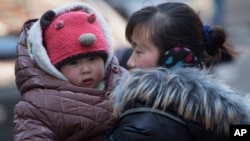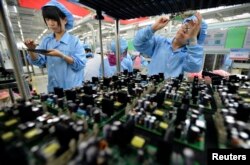China has ended its long-standing, one-child policy and will now allow all couples to have two children.
The plan was unveiled Thursday following high-level, closed-door political meetings this week in Beijing.
Analysts said a two-child policy, while a welcome move, will do little to help lift the country’s declining birth rate or shrinking workforce.
The two-child policy is a further relaxation, after China, in late 2013, allowed couples, one of whom has no siblings, to have a second child.
What to Know About China's One-child Policy
China's One-child Policy
Policy: China first instituted its one-child policy in 1980 in a bid to control the country’s population, which is the world's largest, at nearly 1.4 billion.
Controversy: The restrictions have led to an imbalanced sex ratio because of a traditional preference for boys -- studies say there are 117 boys for every 100 girls. Also, heavy-handed enforcement sometimes included forced abortions and sterilizations.
Amendments: In late 2013, China began to allow couples, one of whom has no siblings, to have a second child.
Why the change: The Chinese Academy of Social Sciences estimates the workforce will being losing as many as 1.55 million people every year before 2020, 7.9 million between 2020 and 2030, and as many as 8.35 million between 2030 and 2050.
Will new policy help? Analysts say a two-child policy will do little to help lift the country’s declining birth rate or shrinking workforce.
Also, Professor Jiang Quanbao of Xi'an Jiantong University said too many people of child-bearing age may no longer want two children. And even with the new policy, it will take 20 years before those children could enter the workforce.
Policy eased
China first instituted its one-child policy in 1980 in a bid to control the country’s population, which is the largest in the world. But heavy-handed enforcement of the measure, including forced abortions, has long been a source of controversy outside China.
More recently it has been blamed as a reason why the country’s workforce is shrinking at an alarming rate.
“Even if two children are allowed, too many young people in the cities are probably no longer interested in having a second child,” said Jiang Quanbao, a professor from Xi'an Jiantong University's Institute for Population and Development Studies.
“Relatively speaking, people in rural farming villages may be more interested," Jiang added. "But again, some of them are already allowed to have two children."
A total of 19 rural provinces in China had already launched a partial two-child policy, which allows couples to have a second child if their first child is a girl so as to address the nation’s gender imbalance problem.
With a population of 1.37 billion, China’s total workforce by the end of last year was a massive 1 billion strong, with about 800 million participating in the job market.
But beginning this year, the Chinese Academy of Social Sciences estimates that the market will lose as many as 1.55 million people every year before 2020, 7.9 million between 2020 and 2030, and as much as 8.35 million between 2030 and 2050.
Labor source
Such a steep slide in the workforce is expected to put a lid on the nation’s demographic dividend and its role as a source of cheap labor.
“The cost of labor in China has greatly increased, which hurts the nation’s status as the world’s factory. With a higher labor cost, international investors are sure to favor other countries over China,” Jiang said.
Even with a new two-child policy, it will take another 20 years before the next wave of babies could help ease the labor shortage problem, the professor added.
Making things worse, the current working population from rural provinces are forced to exit the job markets in the cities earlier than expected as a result of rising property prices and the nation’s rigid household registration system.
That has created bigger hurdles for the nation’s labor force to be fully utilized, said Ran Tao, director of the China Center for Public Economics and Governance at Renmin University.
“If both the land and household registration reforms can be pushed forward, the labor-force shortage can be easily alleviated by the full utilization of the working population from rural provinces. This will be a quicker fix than the implementation of the two-child policy,” Tao said.









